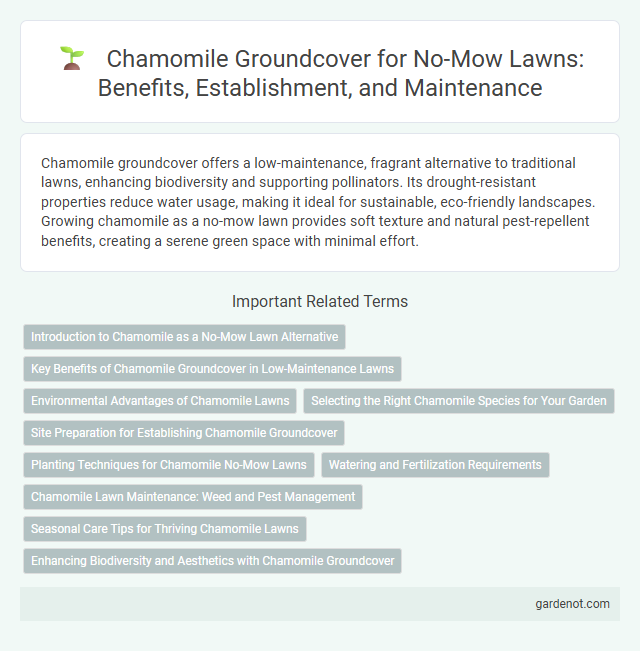Chamomile groundcover offers a low-maintenance, fragrant alternative to traditional lawns, enhancing biodiversity and supporting pollinators. Its drought-resistant properties reduce water usage, making it ideal for sustainable, eco-friendly landscapes. Growing chamomile as a no-mow lawn provides soft texture and natural pest-repellent benefits, creating a serene green space with minimal effort.
Introduction to Chamomile as a No-Mow Lawn Alternative
Chamomile groundcover offers an excellent no-mow lawn alternative with its low-growing, drought-tolerant nature and fragrant, daisy-like flowers. It thrives in well-drained soils and requires minimal maintenance, making it ideal for sustainable landscaping and water conservation. Its soft texture and natural resilience provide a visually appealing, eco-friendly option for homeowners seeking to reduce lawn upkeep.
Key Benefits of Chamomile Groundcover in Low-Maintenance Lawns
Chamomile groundcover offers excellent drought tolerance and natural pest-repellent properties, making it ideal for low-maintenance no-mow lawns. Its soft, aromatic foliage creates a lush, green carpet that requires minimal watering and mowing, reducing overall lawn care efforts. Chamomile also enhances soil quality by fixing nitrogen, promoting a healthier and more sustainable lawn ecosystem.
Environmental Advantages of Chamomile Lawns
Chamomile lawns offer significant environmental advantages by promoting biodiversity and supporting beneficial insect populations, including pollinators such as bees and butterflies. Their drought-resistant nature reduces water consumption, making them an eco-friendly alternative to traditional turfgrass. Furthermore, chamomile's low maintenance requirements minimize the need for chemical fertilizers and pesticides, enhancing soil health and reducing pollution.
Selecting the Right Chamomile Species for Your Garden
Selecting the right chamomile species for a no-mow lawn involves choosing between Roman chamomile (Chamaemelum nobile) and German chamomile (Matricaria chamomilla), with Roman chamomile favored for its low-growing, hardy groundcover properties. Roman chamomile forms dense mats that require minimal maintenance and tolerate light foot traffic, making it ideal for sustainable, no-mow lawn alternatives. Understanding the climate zone and soil conditions helps optimize growth, as Roman chamomile thrives in well-drained soils and full sun to partial shade.
Site Preparation for Establishing Chamomile Groundcover
Site preparation for establishing chamomile groundcover requires well-drained, sandy to loamy soil with a pH range of 6.0 to 7.5, ensuring optimal root development and growth. Removing existing vegetation, loosening the soil to a depth of 4 to 6 inches, and incorporating organic matter enhance soil aeration and nutrient availability for chamomile seedlings. Proper site preparation minimizes weed competition and supports a dense, healthy chamomile groundcover ideal for no-mow lawn applications.
Planting Techniques for Chamomile No-Mow Lawns
Plant chamomile no-mow lawns by sowing seeds evenly in well-prepared, nutrient-rich soil with pH levels between 6.0 and 7.0 to ensure optimal germination. Use light soil coverage of approximately 1/8 inch and maintain consistent moisture during the initial growth phase to promote dense, low-growing mats. Incorporate chamomile with compatible groundcovers like creeping thyme or clover to enhance weed suppression and increase lawn durability without frequent mowing.
Watering and Fertilization Requirements
Chamomile groundcover thrives in well-drained soil with moderate watering, requiring only occasional irrigation during prolonged dry spells to maintain its lush appearance. Overwatering can lead to root rot, so it's essential to allow the soil to dry out slightly between watering sessions. Minimal fertilization is needed; a light application of balanced, slow-release fertilizer in early spring supports healthy growth without encouraging excessive foliage.
Chamomile Lawn Maintenance: Weed and Pest Management
Chamomile groundcover thrives with minimal lawn maintenance, requiring careful weed and pest management to ensure a healthy no-mow lawn. Regularly inspecting the lawn for invasive weeds and removing them by hand helps prevent competition for nutrients and sunlight. Natural pest deterrents such as neem oil or insecticidal soap effectively control pests without harming the delicate chamomile plants or soil ecosystem.
Seasonal Care Tips for Thriving Chamomile Lawns
Chamomile groundcover thrives with spring and fall aeration, promoting healthy root development and soil oxygenation for robust growth. Regularly trim chamomile lawns to a height of 1 to 2 inches to prevent overgrowth and enhance sunlight penetration, supporting dense, vibrant coverage. Applying a light layer of organic mulch during winter conserves moisture and insulates roots, ensuring the chamomile lawn remains lush through seasonal changes.
Enhancing Biodiversity and Aesthetics with Chamomile Groundcover
Chamomile groundcover enhances biodiversity by attracting pollinators such as bees and butterflies, promoting a balanced ecosystem within a no-mow lawn. Its dense, low-growing foliage suppresses weeds naturally, reducing the need for chemical herbicides and fostering healthier soil. The delicate white and yellow flowers add visual appeal, creating a tranquil and aromatic landscape that complements sustainable garden design.
Chamomile groundcover Infographic

 gardenot.com
gardenot.com